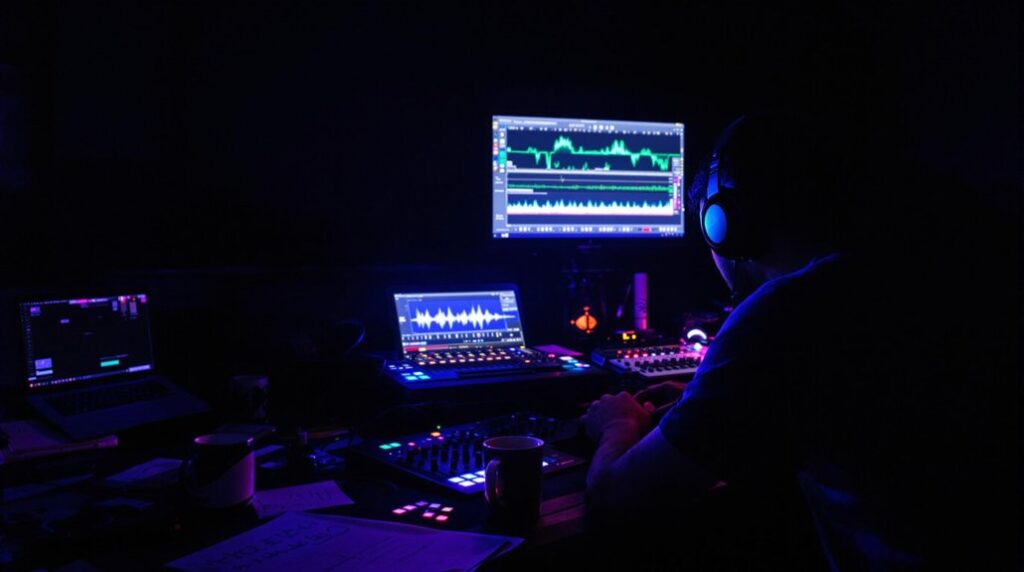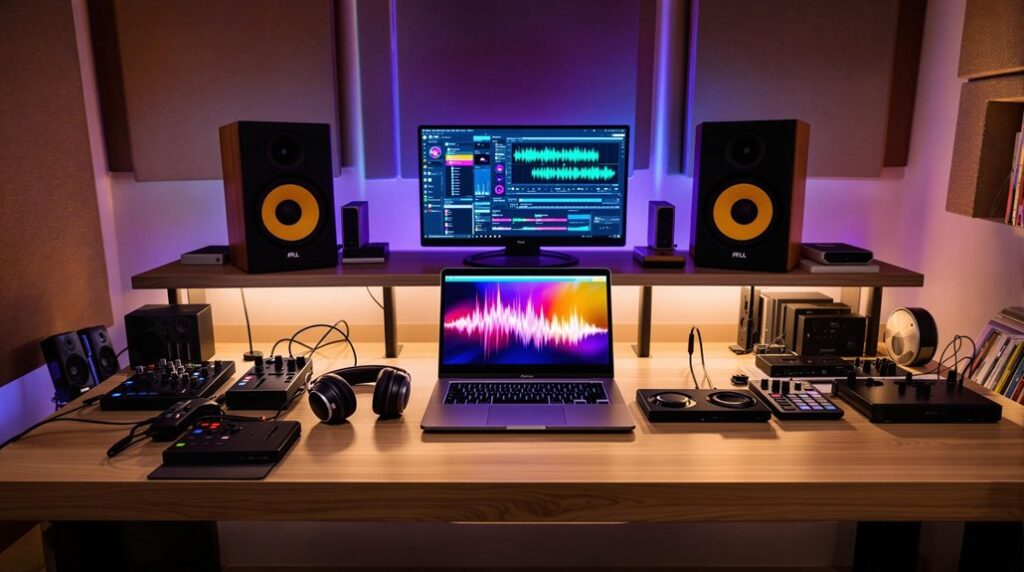Use saturation to add warmth and character to your audio by emulating analog gear like tape machines and tube amplifiers. Saturation introduces harmonic coloration, enriching signals and adding depth and presence. Analog and digital saturation plugins provide versatile options, from tape emulation to transistor distortions. Enhance bass with tube saturation for warmth or use tape saturation on drums for punch and texture. On the master bus, subtle saturation can glue your mix together, giving it a cohesive, analog-like feel. Adjust parameters carefully to avoid distortion and discover how saturation can transform your tracks into rich, emotionally engaging soundscapes.
Key Takeaways
- Apply tape or tube saturation to introduce analog warmth and enhance harmonic richness.
- Experiment with different saturation types to add depth and character to your audio.
- Use subtle saturation on the master bus for cohesion and an analog-like feel.
- Enhance bass with tube or tape saturation for a warm, rounded, and vintage tone.
- Apply parallel saturation on drums to reduce harshness and add punch and texture.
Understanding Audio Saturation
Understanding audio saturation begins with knowing how introducing subtle distortion can enhance the warmth and character of your sound. When you apply saturation techniques, you’re essentially emulating the effect of overloading analog gear, like tape machines and tube amps, which historically gave recordings their rich, pleasing texture.
By adding harmonic coloration, these techniques inject depth, presence, and cohesion into your mix.
The magic happens because saturation introduces harmonics—multiples of the original frequencies—that enrich the audio signal. This harmonic coloration isn’t just about adding random noise; it’s about creating a more complex and engaging sound palette.
For example, tape saturation adds even-order harmonics, resulting in a warm, smooth tone. Tube saturation, on the other hand, introduces both even and odd-order harmonics, offering a rich and dynamic feel.
Using these saturation techniques, you can transform sterile digital recordings into more analog-sounding tracks. By smoothing out harsh transients and subtly compressing the audio, saturation adds excitement and life to your mix.
Harnessing these methods effectively can enhance your production, making it feel more organic and emotionally resonant.
Types of Saturation Plugins
When exploring saturation plugins, you’ll find both analog and digital options that each bring unique qualities to your audio.
Analog saturation plugins, like tape and tube emulators, provide warmth and harmonic richness reminiscent of classic gear.
Digital saturation tools, on the other hand, offer precise control and a wide range of creative possibilities.
Analog Saturation Plugins
Analog saturation plugins, such as tape emulations, tube saturations, and transistor distortions, bring the rich warmth and vintage character of classic analog gear into your digital audio workstation. These plugins excel in signal processing, adding harmonics, compression, and color to your audio signals. If you’re aiming for that unmistakable vintage sound, incorporating these tools is essential.
Tape emulation plugins replicate the subtle saturation and natural compression found in tape machines. This type of saturation adds a warm, smooth character to your audio, making it more cohesive and full-bodied.
Tube saturation plugins, on the other hand, are designed to mimic the behavior of tube amplifiers. They introduce even-order harmonics, which enhance the harmonic richness and depth of your mix, giving it a pleasing, warm distortion.
Transistor distortion plugins provide a different flavor of saturation, emulating the characteristics of transistor-based circuits. This type of saturation can add a bit more edge and grit to your audio, which is perfect for adding unique character and texture to your tracks.
Digital Saturation Tools
Building on the rich textures of analog saturation plugins, digital saturation tools offer a versatile array of options like tape emulation, tube saturation, transistor modeling, and preamp saturation to seamlessly infuse your mixes with warmth, harmonics, and distinctive character. These digital tools aim to replicate the analog warmth and unique color of vintage hardware in a convenient digital format, providing you with a multitude of creative techniques for sound design.
Digital saturation plugins can be tailored to suit your specific needs. For instance, tape emulation plugins can add vintage warmth and subtle harmonic distortion, while tube saturation plugins can bring a creamy, smooth character to your audio. Transistor modeling can introduce a gritty, edgy texture, and preamp saturation plugins can enhance the overall thickness and presence of your tracks.
Here are three notable benefits of using digital saturation tools:
- Flexibility: Easily adjust the amount and type of saturation to achieve the desired effect.
- Convenience: Access a variety of saturation types without the need for physical hardware.
- Control: Precisely shape your sound with detailed parameters and presets.
Benefits of Saturation
You’ll find that saturation does more than just warm up your audio—it can enhance its visual appeal by making waveforms look more dynamic.
This effect also boosts the emotional connection with listeners by adding a layer of richness and depth.
Additionally, saturation highlights key elements in a mix, making them stand out with greater clarity and presence.
Enhancing Visual Appeal
Saturation’s ability to enhance visual appeal lies in its power to inject warmth and character into audio signals, transforming lifeless tracks into vibrant, engaging soundscapes. When you apply saturation, you’re not just adding harmonics; you’re improving clarity and balancing frequencies. This technique helps each element in your mix occupy its own space, ensuring that sounds aren’t muddied or competing with one another.
By incorporating saturation, you’re able to add analog warmth and fullness to your digital recordings, making them more compelling and professional. This technique can be particularly effective in:
- Improving clarity: Saturation can bring out the nuances in your audio, making each instrument or vocal line more distinct.
- Balancing frequencies: By subtly enhancing harmonic content, saturation helps to even out your mix, preventing any one frequency range from becoming overpowering.
- Adding depth and texture: With saturation, your tracks will have a richer, more dimensional sound that stands out.
Utilizing saturation creatively allows you to craft a cohesive and vibrant mix with a unique sonic signature. By injecting this analog warmth and fullness, your recordings won’t only sound better but also feel more engaging and alive.
Boosting Emotional Connection
By enhancing visual appeal through improved clarity and balanced frequencies, you can also boost the emotional connection in your music with saturation. When you apply saturation, you’re not just adding harmonics and warmth; you’re creating an intimate sonic landscape that can evoke deep emotional responses.
This subtle distortion and enriched harmonic content can amplify the emotional resonance of your tracks, allowing listeners to feel a stronger connection to the music.
Saturation works by introducing a gentle compression that adds tonal richness, making your music sound fuller and more engaging. This added depth can transport listeners to a nostalgic state, reminiscent of analog recordings that many find emotionally comforting.
As you saturate your tracks, you’ll notice an increase in perceived loudness and tonal warmth, which can make your music more inviting and emotionally impactful.
Highlighting Key Elements
Leveraging saturation in your mix can instantly highlight key elements by adding warmth, depth, and character to your audio. By introducing harmonics and subtle distortion, saturation enhances the fullness and richness of sound, making digital recordings sound more analog and organic.
Here are a few mixing tips to make key elements in your mix stand out:
- Enhance saturation in your mix: Saturation can tame sharp peaks, making your mix more cohesive and less fatiguing to the ear.
- Explore depth and texture: Using creative applications of different saturation types, like tape, tube, or transistor, adds unique characteristics to your tracks.
- Improve mix cohesion: Subtle saturation can glue elements together, providing a more polished and professional sound.
When applying saturation, it’s important to use artistic techniques to avoid overdoing it. Subtlety is key—just enough to add warmth and character without muddying your mix. Experiment with different saturation plugins and hardware to find the right flavor for your sound.
This production trick can help your key elements, such as vocals or lead instruments, stand out in the mix, ensuring they capture the listener’s attention. So, explore these creative applications and enhance your mix to the next level.
Applying Saturation to Bass
Applying saturation to the bass can transform your track by injecting depth, warmth, and character, making it stand out in the mix.
By adding subtle coloration, you can enhance the harmonic richness of your bass, allowing it to fill out the low end more effectively. Different types of saturation, such as tube or tape emulation, offer unique tonal and textural qualities.
Tube saturation can impart a warm, rounded sound, while tape emulation can add a smooth, vintage feel.
To achieve the perfect balance, start by adjusting the saturation amount. Too much can overwhelm the mix, but a touch of subtle coloration can enhance the bass without making it muddy.
Tone controls are equally important; tweaking these can help you shape the harmonics and frequencies to fit the overall mix better.
Experimenting with various saturation plugins and settings is essential. Each plugin has its unique character and can offer different levels of warmth and depth.
Don’t be afraid to try out different combinations until you find the one that adds the desired level of warmth and character to your bass track. This nuanced approach guarantees your bass remains impactful and prominent in the mix.
Enhancing Drums With Saturation
Saturation on drums can transform their impact, reducing harshness while adding punch and character to the mix. By using saturation plugins, you can enhance drum texture and introduce harmonic richness that makes each hit more dynamic and engaging.
Tube or tape saturation particularly excels at creating saturation depth and managing transient control, ensuring that your drum tracks remain powerful without becoming overwhelming.
To achieve the best results, consider these approaches:
- Experiment with different saturation types on individual drum elements to find the perfect balance.
- Apply parallel saturation on drum buses to blend clean and saturated signals for a textured mix.
- Use saturation to tame harsh transients, making the drums sit better within the overall mix.
Each drum element, whether it’s the kick, snare, or hi-hats, can benefit from a tailored saturation approach. For example, applying gentle tape saturation to the kick drum can add weight and warmth, while tube saturation on the snare can introduce snap and presence.
Master Bus Saturation Techniques
Master bus saturation techniques can be a game-changer, adding warmth, cohesion, and an analog-like character to your entire mix. By applying saturation on the master bus, you introduce harmonics and subtle compression that can enhance the overall sound. This is one of the mastering techniques that can help enhance your mix together, creating a cohesive and polished final product.
In your quest for mixing secrets, remember to adjust the amount of saturation carefully. Too much can overload the mix, causing distortion and loss of clarity. A subtle touch can work wonders, adding richness without compromising the integrity of your sound.
Creative applications of master bus saturation can also improve your sound design. For instance, you can use different types of saturation—like tape, tube, or transistor—to achieve varying textures and warmth. Each type has its own character, and experimenting with them can lead to unique sonic qualities in your mix.
Ultimately, mastering these techniques can contribute to a more analog-like feel in your digital productions, offering that sought-after warmth and character. By incorporating these methods, you’ll be well on your way to crafting mixes that sound professional and engaging.
Frequently Asked Questions
What Does Adding Saturation Do?
Adding saturation introduces harmonic distortion, enriching your audio with tonal enhancement. It mimics analog warmth, making digital recordings sound more organic and lively, while adding depth, character, and richness to your mixes.
How to Add Warmth to Your Mix?
To add warmth to your mix, use tape saturation plugins to emulate analog warmth. Apply tube emulation for rich harmonics on vocals and guitars. Blend saturated and unsaturated signals in parallel to finely control the warmth.
What Does Saturation Do to Vocals?
Saturation adds harmonic enhancement and analog emulation to your vocals. You’ll achieve a richer, warmer, and more natural sound, smoothing out harsh transients and providing a polished, professional quality that stands out in your mix.
When Should You Use Saturation?
You should use saturation when you need to tame harsh transients or enhance analog emulation. Tape saturation works great for adding warmth and depth, making your mix sound cohesive and giving it a unique, vintage vibe.
Conclusion
By mastering audio saturation, you can infuse warmth and character into your mixes.
Utilize various saturation plugins to enhance individual elements like bass and drums, ensuring they stand out with rich, harmonic content.
Don’t overlook the master bus for a cohesive, polished final product.
With these techniques, you’ll transform sterile recordings into vibrant, emotive tracks that captivate listeners, showcasing your technical prowess and creative ingenuity.
Now, go ahead and enhance your sound!




